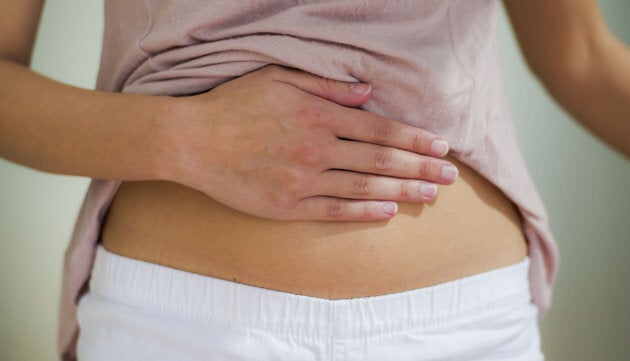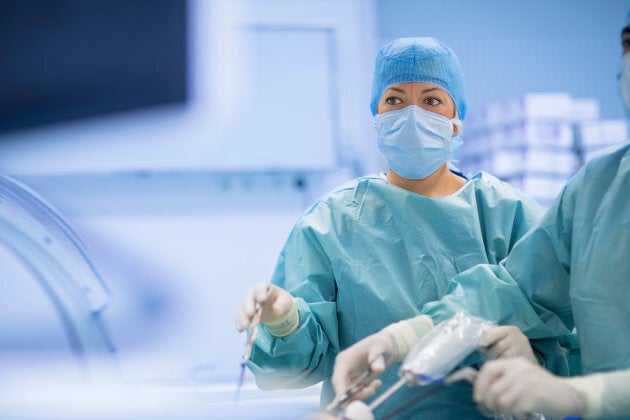Only a few years ago, endometriosis -- a condition that affects one in ten Australian women -- was lived with quietly and not really talked about.
That's slowly changing, thanks to awareness campaigns by women living with the life-changing condition, including celebrities like Lena Dunham, Jackie O, Halsey, Susan Sarandon and Whoopi Goldberg.
But what actually is 'endo', and why does it seem that, for so many women, there is no way out of the crippling pain and risk of infertility that it brings?
Essentially, endometriosis is when the cells similar to those which line a woman's uterus (the endometrium) start to grow in other areas -- most commonly, on pelvic organs such as the ovaries, fallopian tubes, bowel and bladder.
A lot of the time a woman goes to her doctor and is told 'it's period pain, it's normal, put up with it'."
When a woman has her monthly period, the blood not only flows out her vagina, but also goes backwards along the fallopian tubes and into the pelvis. In nine out of 10 women, the blood containing endometrial cells is absorbed or broken down, but in some women, the endometrial tissue latches onto other organs and starts to grow.
Once enough tissue has grown, the growths begin to bleed in conjunction with a woman's menstrual cycle, frequently causing severe pain and, sometimes, infertility.
It's not clear why this happens in some women and not others, although women who have close relatives with the disease are much more likely to suffer. This has led researchers to suspect a genetic element.
Myths About Endometriosis
- Myth: All women who have endometriosis have severe period pain.
- Fact: Some women actually have no symptoms at all -- it's estimated one in four women with endometriosis don't have any pain.
- Myth: If you have endometriosis, you can't have children.
- Fact: Most women with endometriosis are still able to have children, although it can be more difficult to conceive. Early diagnosis and treatment will help a woman remain fertile.
- Myth: My GP will able to tell me if I have endometriosis.
- Fact: The only way to definitely determine if you have endometriosis is to have a laparoscopy -- surgery which requires a general anesthetic. Best practice is to remove any endometriosis found at the same time, so only one procedure is required.
- Myth: A hysterectomy will cure the disease.
- Fact: There is no cure. In severe cases, a hysterectomy may relieve symptoms but the endometriosis may come back.
Endometriosis is seriously underdiagnosed all over the world.
In Australia, it takes on average seven years for a woman to be diagnosed with endometriosis from the time she first seeks help.
That means that if a girl develops severe period pain at the time she starts high school, she could well be at university before she finds out what is going on. During that time, her condition is likely to have worsened.
As well as the overwhelming human cost, a 2014 study by University of Sydney researchers estimated that it costs the Australian economy $7.7 billion each year, two thirds of which is due to lost productivity.
So if it is so common, why does it take so long to get diagnosed?

"A lot of the time a woman goes to her doctor and is told 'it's period pain, it's normal, put up with it'," Dr Elizabeth Farrell, Medical Director at Jean Hailes for Women's Health, told HuffPost Australia.Dr Farrell wants this attitude to change. She says the first step is recognising that crippling period pain is not normal -- especially when the pain isn't relieved by taking traditional pain killers.
"This should not be at all. Women should be able to be investigated and managed if they have severe pain," she said.
"If someone is not able to manage their daily life because of the pain; if their quality of life is impaired; if they can't manage their studies or their job -- even if they push through it and go to work but their productivity is down -- that is reason enough to go and say 'I want something done. I want to be referred to someone who specialises in endometriosis'."
Another reason it takes so long for women to be diagnosed is that endometriosis looks different in different women.
"It seems that adolescents who develop endo have a different picture to women who develop it later in life," Dr Farrell said.
"It's a slightly more diffuse picture of little blisters compared to older women, where it might be more discreet in particular areas. It seems to look like a different condition almost -- it is endometriosis, but it's slightly different."
Teenage girls will also often respond better to hormonal treatments such as the contraceptive pill.
A common treatment for endometriosis, the Pill doesn't cure the disease, but by stopping monthly bleeding, it can ease the pain and slow or halt the growth of the endometrial tissue.
The Stages Of Endometriosis
Stage 1: Mild or minimal - There are small endometrial patches/plaques, inflammation and mild adhesions.
Stage 2: Mild - There are many endometrial patches with possible scarring, as well as adhesions between the uterus and the rectum (called the Pouch of Douglas).
Stage 3: Moderate - As above, but adhesions also involve the ovaries.
Stage 4: Severe - A large number of deep endometrial growths, which may form scarred nodules. The tissue will have spread to other organs such as the bladder and bowel. There may be changes to the shape of the pelvic organs.
Credit: Jean Hailes for Women's Health
Period pain is the main symptom of endometriosis, affecting three out of four women with the disease, but it is far from the only one.
Moreover, a woman may have severe endometriosis and not experience any symptoms. Contrarily, she may have incapacitating pain yet only mild endometrial growths. This largely depends on where the endometriosis is.
Depending on where it is growing, women may also experience back pain, pain passing urine or opening their bowels, heavy menstrual bleeding, irregular periods, constipation and diarrhoea, frequent urination, increased bloating during their period, tiredness, pain during or after sex, and infertility.
As the disease progresses, a woman may also get abdominal pain outside of her usual monthly period.
Of course, many of these symptoms are also associated with other conditions -- such as Polycystic Ovarian Syndrome and Irritable Bowel Syndrome -- which can lead to misdiagnoses and delays in treatment.
Often, a woman won't find out she has endometriosis until she tries to get pregnant.
"About a third of women who present for infertility investigation are found to have endometriosis," Dr Farrell said.
While endometriosis doesn't mean you can't get pregnant, there are several things which can make it more difficult.

Endometrial growths on a woman's reproductive organs may block the path of the egg and sperm. Scarring on the uterus can also make it more difficult for a fertilised egg to implant on the uterus wall and develop into a pregnancy.
Pain during sex can also lead to women avoiding it altogether.
Dr Farrell says there is also suspected to be a hormonal component, as some women who have no obvious blockages or scarring still experience problems with fertility.
A healthy diet and regular exercise can help stabilise hormones and assist with fertility, and surgery to remove the endometrial tissue may help prevent blockages.
As yet, there is no cure for endometriosis.
Some women with severe endometriosis who aren't seeking to have children may elect to have a hysterectomy to help ease their symptoms, but it's no guarantee that it won't return.
The Pill or other hormonal treatment may ease symptoms and help prevent further growth, but cannot reduce the endometrial tissue already present.
Currently, the gold standard for treating endometriosis is through a laparoscopy -- which is also the only way to definitely confirm the presence of endometriosis.

A small operation requiring a general anaesthetic, the operation involves a small incision and the removal of all endometrial tissue. The recovery time for this surgery is generally around five to seven days.
In severe cases, a more severe form of surgery, called a laparotomy, may be required in order to remove all the adhesions. This involves making a larger cut in the abdomen, with a recovery time of around six weeks.
Removing the endometriosis not only relieves pain; it can also improve a woman's chances of falling pregnant. But it is not a cure.
No treatment can ensure the disease won't return -- women frequently undergo multiple surgeries over the course of their reproductive years. But increased awareness, early diagnosis and comprehensive treatment from endometriosis specialists can help improve the lives of the 560,000 Australian women with the disease.
ALSO ON HUFFPOST AUSTRALIA